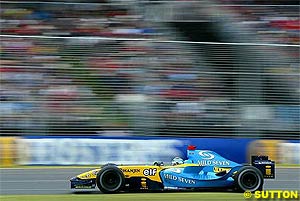Atlas F1 Magazine Writer
Fresh from the Formula One paddock
"Normally as racing drivers we are happy to go faster, but now the cars are too fast. It is something for the technical people to sort out."
Now, not even triple World Champion John Young Stewart, at the height of his (absolutely justified) 1970s safety campaign, questioned the very essence of a Formula One pilot's craft: speed through science. What the Tyrrell driver did abhor, though, after the deaths of over 50 fellow drivers, was unnecessary danger to spectators, mates and colleagues, and his efforts were eventually rewarded with measures which saved four generations of drivers, and will save countless more in future.
But, his campaigns, for there were many over a four-year period, were aimed not at "technical people", but at the CSI (then the sporting division of the FIA), and promoters and track owners, and fundamentally revolved around circuit facilities and standards. Basically, if a circuit was as safe as conceivably possible for the speeds attained, Stewart and his colleagues would race it. And, the wee Scot would probably win.
Trulli's comments, though, seemingly refer to speed issues in their own right, and not safety - why else does he refer only to "technical people", and not the sport's regulatory body? And, truth be told, Sepang, where he made the comments, is, with its massive run-off areas, about the safest place to stretch an F1 car, let alone one with inherent primary and secondary safety systems Stewart could only fantasise about.
So, what, then, is the Renault driver on about? Surely, in the presence of all reasonable safety measures, speed - even with laptimes four seconds a lap faster than 52 short weeks before - is what Formula One is all about? Surely that is the rationale behind endless test laps, behind intensive development with rates of progress exceeding even those of NASA programmes, behind mega-millions put up by multi-nationals ranging from car companies to computer conglomerates?
"Technical people" are tasked, via instincts and job descriptions, to produce maximum technology within the prevailing regulations, and anything less leads to ridicule - or abrupt termination - just as race drivers are tasked, surely, to master the technology of the day. And, slow ones get terminated, too. Just as Juan Manuel Fangio fought skinny tyres and drum brakes, JYS mastered wings, Nelson Piquet turbos and ground effects, and Ayrton Senna electronics, so it is for the 2004 grid to master whatever the regulations throw at them.
That (highly-paid) Formula One drivers should actually wish to go slower is anathema to every race fan, and, at a time when the sport is failing to deliver spectacle, they should surely ensure that it delivers speed.
Can BAR-Honda continue their performance surge? Scorned as a point-less upstart in 1999, they found semi-respectability with fifth in the 2000 Championship. Then, the next year, they slipped a slot, and another the year after, before pulling back to fifth last season.
Certainly, all the components for success are now in place. Stability, once a wish-word in Brackley, is there: David Richards is going on for his third season, as is Geoffrey Willis - who must, now that Toyota have seemingly clipped Gustav Brunner's creative wings - rank as the freest thinker in the pitlane. The race team deliver superb pit stops (watch them in action, and decide), and motivation is at an all-time high. In fact, so neat and tidy is their appearance - always an indicator of commitment - that rumours suggesting overalls are changed on the hour, every hour are disproven only the quiet air of efficiency in the garage.
True, JV is gone - a real blessing, say some, although his 'fire' was never in dispute - but, with 2003 tester Takuma Sato promoted to a race seat, the team are working with a known quantity. In line with this continuity, Anthony Davidson has slotted into the Japanese driver's development role, whilst Button, of course, is in his second season with the Honda-powered team. In fact, about the only new face wearing Lucky Strike black/white is a yet-to-be-announced test driver. Watch this space.
JB has matured beyond all recognition, and now walks like a future champion. His podium, after 68 starts, is just reward for the "character-building" he endured in Flavio Briatore's hands during 2001/2, and, if the truth be told, Villeneuve's departure has set "Jens" free. Sato, too, has come a long way - think back to those frightening Jordan days - and Davidson can be relied upon to provide consistent tyre test results on Friday mornings - important when your major opponents in the constructors' stakes (note plural, for Renault, McLaren AND Williams are in their sights) are banned from running third cars.
If Willis' interim test car - fundamentally a hybrid 2003 chassis incorporating new developments which set a string of fastest laps in December/January - was sweet, then 006 beats honey. And, it could get sweeter still if rumours about soon-to-be-unleashed trick aerodynamics (centring around rear wing flow) and Optimum (tyre) Contact Patch systems are anywhere near half-true. Michelin has been known to be working on just such a system, and, it seems, BAR will be the first team to race with full-on OCP technology - Renault are known to have experimented with a version last season - which enables 'soft' compounds to offer wear characteristics of 'hard' compounds via optimal suspension geometry.
The BAR-Michelin tyre partnership is, of course, in its early stages, but Willis - part of Williams' design double-act with Gavin Fisher until his departure in early 2002 - worked with Pierre Dupasquier and his merry men for the preceding three years whilst with his former team. At that stage OCP was mooted, but, with Williams and BMW placing the need for wins ahead of engineering experiments, the matter lay dormant. Now, Honda, which supplies upwards of 25 chassis engineers to BAR on a rotating basis as part of its R&D projects, is, according to a Honda-insider, extremely partial to the concept which was originally intended for road car use in any event.
Talking Honda, the Japanese company has spectacularly upped its commitment to Formula One, pulled out all stops as it returns to respectability. It set itself the ambitious targets of reducing weight and centre-of-gravity whilst upping revs (to 19,000rpm) and power (to over 900bhp) - all at a time when the FIA demanded that engines run for entire race weekends without failure. A tall order, indeed, but the RA004E evolution achieved just that, and more, in testing. And, if Sato's engine blew in Malaysia's heat, remember that Ralf Schumacher's BMW unit did, too.
But, all this counts for nought if that most fundamental requirement of a victorious team - the will-to-win - is absent. This very real, yet intangible, component has, of late, slowly crept into BAR's modus operandi, and was totally evident in Australia and appeared only slightly dampened (by the humidity?) in Malaysia. But, has BAR's early arrogance given way to genuine purpose?
Consider the celebrations after Spain 2001 (JV's first podium for the team) and Germany the same year (the second), and compare those champagne-spraying occasions with Richards' words earlier this week:
"It was very encouraging but we have to make sure we don't get complacent," he said of the podium place. "For Jenson it was a memorable occasion but it's out of the way and finished now. We've got to continue putting ourselves on the podium and in situations where we can be on the podium. There's no question that we can think we're there yet. We don't intend to be complacent after just one podium."
Is there any doubt that BAR's performance will continue?

 So said Grand Prix Drivers' Association director Jarno Trulli reportedly in the aftermath of Malaysia's qualifying, a tedious two-hour session enlivened only by a pole position time no less than four seconds faster than Fernando Alonso's underpowered Renault achieved last year - and Michael Schumacher's Ferrari was weightier by four laps more fuel!
So said Grand Prix Drivers' Association director Jarno Trulli reportedly in the aftermath of Malaysia's qualifying, a tedious two-hour session enlivened only by a pole position time no less than four seconds faster than Fernando Alonso's underpowered Renault achieved last year - and Michael Schumacher's Ferrari was weightier by four laps more fuel!

 Now, following Jenson's Button long-overdue podium - his first, and the outfit's first since scoring two thirds via Jacques Villeneuve in 2001 - in Malaysia, the team lie fourth in the Constructors' Championship: higher than at any stage in their five-and-a-bit year life, and better than achieved by the Tyrrell team (from which they mutated) since 1978.
Now, following Jenson's Button long-overdue podium - his first, and the outfit's first since scoring two thirds via Jacques Villeneuve in 2001 - in Malaysia, the team lie fourth in the Constructors' Championship: higher than at any stage in their five-and-a-bit year life, and better than achieved by the Tyrrell team (from which they mutated) since 1978.
|
Contact the Author Contact the Editor |
Please Contact Us for permission to republish this or any other material from Atlas F1.
|
Volume 10, Issue 13
Atlas F1 Exclusive
Interview with David Richards
Interview with Geoff Willis
Interview with Jenson Button
Interview with Takuma Sato
Articles
Every Other Sunday
The Paint Job: Part IV
Telling Teammates Apart
2004 Bahrain GP Preview
2004 Bahrain GP Preview
Bahrain GP Facts & Stats
Columns
The F1 Trivia Quiz
Bookworm Critique
On the Road
Elsewhere in Racing
The Weekly Grapevine
> Homepage |
